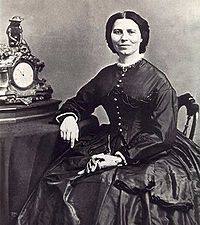

 Clara Barton
“While her brothers and sisters were at school, Clara followed her father around their farm.
~Clara Barton (Young Reader's Christian Library) Clarissa “Clara” Harlowe Barton was born in North Oxford, Massachusetts, on Christmas Day of 1821. Clara was the daughter of Captain Stephen and Sarah Stone Barton. Clara’s parents were active Universalists who helped found the first Universalist Church in Oxford. Her father was a respected farmer, horse breeder, and state lawmaker who had served in the French & Indian Wars. Captain Barton thrilled young Clara with stories that taught her about geography as well as military tactics and logistics. Barton’s childhood family farm is now the “Clara Barton Birthplace Museum.” Clara was the youngest of five children; all of her brothers and sisters were at least ten years older. Clara was extremely bright and by the time she was four years old, she could easily spell three-syllable words. Although Clara spent brief periods in public schools, she received most of her education at home under the tutelage of her brothers and sisters. Dorothy and Sally, both teachers, taught their younger sister how to read, write, and spell. Stephen, a math teacher and businessman, taught her arithmetic. David taught her skills that young women did not usually learn, such as carpentry and athletics. Clara also studied philosophy, chemistry, and Latin. Clara’s vast and diverse education was supplemented with practical experience, working as a clerk and bookkeeper for her oldest brother Stephen. Inspired by stories from her aunt, a midwife who often administered medical care much like a doctor of that era, Clara dreamed of being a nurse. Clara’s brother David became her first patient. At the young age of 11, she nursed him through a serious illness. Clara stayed at his side for nearly three years and learned to administer all of his medicines including the “great, loathsome crawling leeches.” Although Clara had always been a shy girl, she was also well spoken and well read. Clara’s mother encouraged her to become a schoolteacher. At age 15, Clara began teaching in a nearby one-room schoolhouse. By her early 20’s, Miss Barton had founded her own school in North Oxford. Clara’s most notable achievement was the establishment of a free public school in Bordentown, New Jersey. But when the citizens of Bordentown built a larger school, they appointed a man to be the principal instead of Barton. Clara didn’t think that was fair, and she resigned rather than stay on as a teacher. In 1861, Clara moved to Washington, D.C. and became the first woman hired to work as a clerk in the U.S. Patent Office. On April 21, 1861, nine days after the start of the American Civil War, Miss Barton tended to wounded Massachusetts soldiers quartered in the U.S. Senate chamber. Then after the First Battle of Bull Run, July 21, Miss Barton organized a relief program to obtain and distribute supplies to wounded soldiers. The following year, U.S. Surgeon General William A. Hammond granted Clara a pass to travel with army ambulances “for the purpose of distributing comforts for the sick and wounded, and nursing them.” Thus, the battlefields of the Civil War were this young nurse’s first mission field. For three years she followed army operations from Maryland to Virginia to South Carolina. She served at the Second Battle of Bull Run, the Battle of Antietam, and the Battle of Fredericksburg among others. Clara became known as “The Angel of the Battlefield.” Distressed at the lack of proper care for wounded soldiers, Clara sought donations for food, which she cooked into nourishing meals. She delivered these meals to the wounded men herself along with medical supplies. She would often be found at the front lines, rendering heroic assistance and bandaging solders’ wounds. Clara Barton joined Virginia’s Sally Louisa Tompkins in helping develop nursing as a skilled profession during the Civil War. When the Civil War ended, Barton expanded on her concept of soldier aid. Many badly wounded soldiers could not get in touch with their families. Clara started the “Office of the Search for Missing Men” in her Capitol Hill apartment. She lectured across the Northeast and the Midwest, telling of her wartime experiences and publicizing her search. She published lists of names in newspapers and exchanged letters with soldiers’ families. She soon had files on more than 20,000 persons. President Abraham Lincoln even placed Clara in charge of identifying and marking the 13,000 Union soldiers’ graves at Camp Sumter, a prison camp in Andersonville, Georgia. By the end of the Civil War, Barton had performed most of the services that would later be associated with the American Red Cross, which she founded on May 21, 1881. The American Red Cross was the designated U.S. affiliate of the International Federation of the Red Cross based in Geneva, Switzerland. The role of the organization changed somewhat during the Spanish-American War, when it aided refugees and prisoners of war. The American Red Cross would also respond to crises other than war, assisting civilians in disasters such as earthquakes, hurricanes, and floods. Barton’s last field operation as President of the American Red Cross was the relief effort for the victims of the Galveston hurricane in September 1900. The organization established an orphanage for children of the 6,000 dead, helped to acquire lumber for rebuilding houses, and teamed with the New York World newspaper to accept contributions. Barton served as president of the American Red Cross until 1904 when she retired to her home at Glen Echo, outside Washington, D.C., where she lived until the age of 91. Barton died on April 12, 1912, after succumbing to complications of double pneumonia following a cold. Clara never took the time to marry or have children of her own, but she was loved and greatly missed by many. The Detroit Free Press wrote shortly after her death, “She was perhaps the most perfect incarnation of mercy the modern world has known.” It is said that Clara never took on any work without first carefully thinking it through as to where it was to end and how it was going to be provided for, and yet it was during disasters when she showed her true colors. The compassionate, courageous work that Clara Barton performed while caring for people in times of war and peace made her an icon of humanitarianism. She helped the sick and the wounded, the homeless and the hungry. Throughout her long life she sought to improve other people’s lives by, in her own words, “offering a hand up, not a handout.” Barton has inspired countless teachers, medical professionals, and social workers. Today the American Red Cross continues the good work that she began, both in wartime and in emergencies. References:
http://www.redcrossclara.com/History.html
Contact: . Thanks! Please click here for reprint permission.


These pages are a continuous work in progress.
|
Help Support this Site
and purchase items via our affiliate links. Thank you!
 
Thank you for visiting my |

